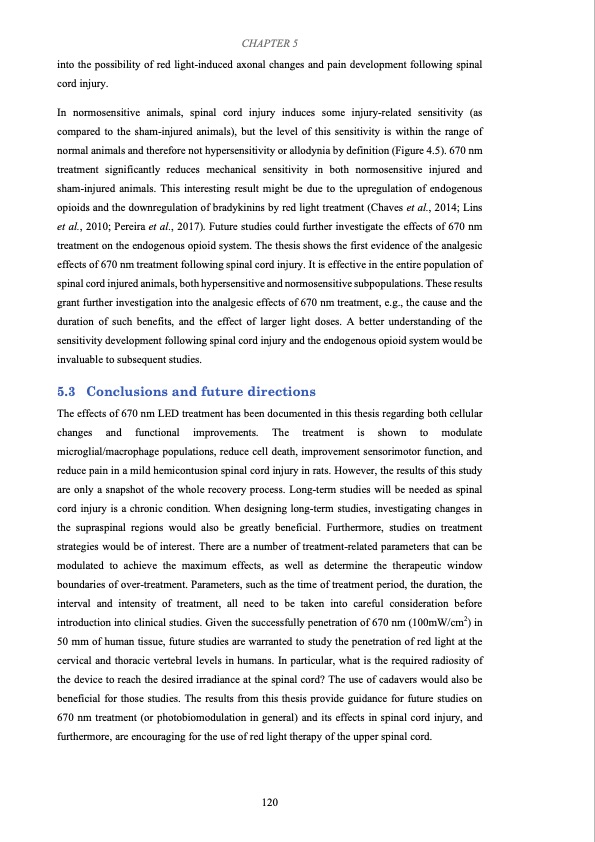
PDF Publication Title:
Text from PDF Page: 134
CHAPTER 5 into the possibility of red light-induced axonal changes and pain development following spinal cord injury. In normosensitive animals, spinal cord injury induces some injury-related sensitivity (as compared to the sham-injured animals), but the level of this sensitivity is within the range of normal animals and therefore not hypersensitivity or allodynia by definition (Figure 4.5). 670 nm treatment significantly reduces mechanical sensitivity in both normosensitive injured and sham-injured animals. This interesting result might be due to the upregulation of endogenous opioids and the downregulation of bradykinins by red light treatment (Chaves et al., 2014; Lins et al., 2010; Pereira et al., 2017). Future studies could further investigate the effects of 670 nm treatment on the endogenous opioid system. The thesis shows the first evidence of the analgesic effects of 670 nm treatment following spinal cord injury. It is effective in the entire population of spinal cord injured animals, both hypersensitive and normosensitive subpopulations. These results grant further investigation into the analgesic effects of 670 nm treatment, e.g., the cause and the duration of such benefits, and the effect of larger light doses. A better understanding of the sensitivity development following spinal cord injury and the endogenous opioid system would be invaluable to subsequent studies. 5.3 Conclusions and future directions The effects of 670 nm LED treatment has been documented in this thesis regarding both cellular changes and functional improvements. The treatment is shown to modulate microglial/macrophage populations, reduce cell death, improvement sensorimotor function, and reduce pain in a mild hemicontusion spinal cord injury in rats. However, the results of this study are only a snapshot of the whole recovery process. Long-term studies will be needed as spinal cord injury is a chronic condition. When designing long-term studies, investigating changes in the supraspinal regions would also be greatly beneficial. Furthermore, studies on treatment strategies would be of interest. There are a number of treatment-related parameters that can be modulated to achieve the maximum effects, as well as determine the therapeutic window boundaries of over-treatment. Parameters, such as the time of treatment period, the duration, the interval and intensity of treatment, all need to be taken into careful consideration before introduction into clinical studies. Given the successfully penetration of 670 nm (100mW/cm2) in 50 mm of human tissue, future studies are warranted to study the penetration of red light at the cervical and thoracic vertebral levels in humans. In particular, what is the required radiosity of the device to reach the desired irradiance at the spinal cord? The use of cadavers would also be beneficial for those studies. The results from this thesis provide guidance for future studies on 670 nm treatment (or photobiomodulation in general) and its effects in spinal cord injury, and furthermore, are encouraging for the use of red light therapy of the upper spinal cord. 120PDF Image | Effects of Red Light Treatment on Spinal Cord Injury

PDF Search Title:
Effects of Red Light Treatment on Spinal Cord InjuryOriginal File Name Searched:
Thesis_Di Hu_final.pdfDIY PDF Search: Google It | Yahoo | Bing
Cruise Ship Reviews | Luxury Resort | Jet | Yacht | and Travel Tech More Info
Cruising Review Topics and Articles More Info
Software based on Filemaker for the travel industry More Info
The Burgenstock Resort: Reviews on CruisingReview website... More Info
Resort Reviews: World Class resorts... More Info
The Riffelalp Resort: Reviews on CruisingReview website... More Info
| CONTACT TEL: 608-238-6001 Email: greg@cruisingreview.com | RSS | AMP |